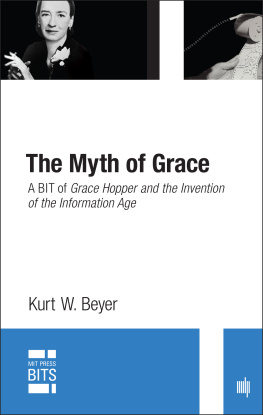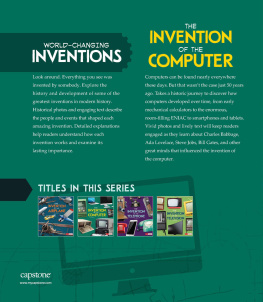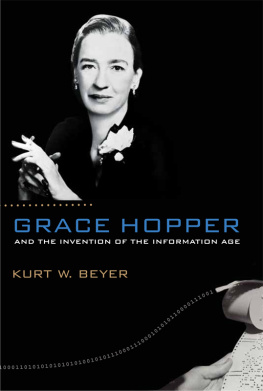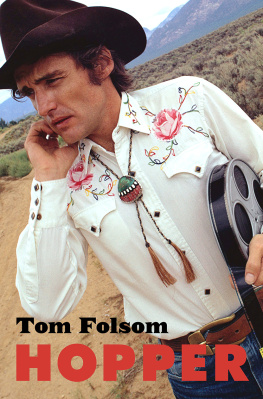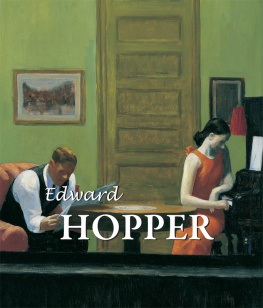
GRACE HOPPER AND THE INVENTION OF THE INFORMATION AGE
LEMELSON CENTER STUDIES IN INVENTION AND INNOVATION
ARTHUR P. MOLELLA AND JOYCE BEDI, GENERAL EDITORS
Arthur P. Molella and Joyce Bedi, editors, Inventing for the Environment
Paul E. Ceruzzi, Internet Alley: High Technology in Tysons Corner, 19452005
Robert H. Kargon and Arthur P. Molella, Invented Edens: Techno-Cities of the Twentieth Century
Kurt Beyer, Grace Hopper and the Invention of the Information Age
GRACE HOPPER AND THE INVENTION OF THE INFORMATION AGE
KURT BEYER
THE MIT PRESS
CAMBRIDGE, MASSACHUSETTS
LONDON, ENGLAND
2009 Massachusetts Institute of Technology
All rights reserved. No part of this book may be reproduced in any form by any electronic or mechanical means (including photocopying, recording, or information storage and retrieval) without permission in writing from the publisher.
For information on quantity discounts,
Set in Engravers Gothic and Bembo by SNP Best-set Typesetter Ltd., Hong Kong. Printed and bound in the United States of America.
Library of Congress Cataloging-in-Publication Data
Beyer, Kurt W.
Grace Hopper and the invention of the information age/Kurt W. Beyer.
p. cm.(Lemelson Center studies in invention and innovation series)
Includes bibiographical references and index.
ISBN 978-0-262-01310-9 (hardcover : alk. paper)
1. Hopper, Grace Murray. 2. Women computer engineersUnited StatesBiography. 3. Computer scienceUnited StatesHistory.
I. Title.
QA76.2.H67B49 2009 004.092dc22 2008044229
10 9 8 7 6 5 4 3 2 1
for my late father, Karl Beyer
CONTENTS
| SERIES FOREWORD |
| ACKNOWLEDGEMENTS |
| 1 THE MYTH OF AMAZING GRACE |
| 2 THE REBIRTH OF GRACE MURRAY HOPPER |
| 3 THE ORIGINS OF COMPUTER PROGRAMMING |
| 4 THE HARVARD COMPUTATION LABORATORY |
| 5 THE BEGINNING OF A COMPUTING COMMUNITY |
| 6 THE 1947 HARVARD SYMPOSIUM ON LARGE-SCALE DIGITAL CALCULATING MACHINERY |
| 7 STARING INTO THE ABYSS |
| 8 THE EDUCATION OF A COMPUTER |
| 9 IBM ANSWERS REMINGTON RANDS CHALLENGE |
| 10 THE DEVELOPMENT OF PROBLEM-ORIENTED LANGUAGES |
| 11 DISTRIBUTED INVENTION MATURES: GRACE HOPPER AND THE DEVELOPMENT OF COBOL |
| 12 INVENTING THE INFORMATION AGE |
| NOTES |
| INDEX |
SERIES FOREWORD
Invention and innovation have long been recognized as significant forces in American history, not only in technological realms but also as models in politics, society, and culture. They are arguably more important than previously thought in other societies as well. What there is no question about is that they have become the universal watchwords of the twenty-first century, so much so that nations are staking their futures on them.
Since 1995, the Smithsonians Lemelson Center has been investigating the history of invention and innovation from such broad interdisciplinary perspectives. So, too, does this series, the Lemelson Center Studies in Invention and Innovation. Books in the series explore the work of inventors and the technologies they create in order to advance scholarship in history, engineering, science, and related fields that have a direct connection to technological invention, such as urban planning, architecture, and the arts. By opening channels of communication between the various disciplines and sectors of society concerned with technological innovation, the Lemelson Center Studies aim to enhance public understanding of humankinds inventive impulse.
Arthur Molella and Joyce Bedi
ACKNOWLEDGEMENTS
I first came across Admiral Grace Murray Hopper when I was a teenager attending my sisters graduation from the College of William and Mary. The fiery speaker stoked my imagination and influenced my own career choices, first as a naval officer, then as an academic, and finally as an information technology entrepreneur.
Hopper was a well-known figure in the Navy, but when I arrived at the University of California at Berkeley I found, to my surprise, that many people there did not know about her accomplishments. Berkeley in the late 1990s was at the epicenter of the dot com boom, a phenomenon dominated by young male entrepreneurs who slept under their desks, dreamed of stock options, and believed they were inventing the Information Age for the first time.
Under the guidance of Cathryn Carson, Jack Lesche, Todd La Porte, Roger Hahn, and Thomas Hughes, I began piecing together the evolution of the Information Age.
Not only did Grace Hopper play a pivotal role in creating the foundation for the computer industry; she was surrounded by remarkable men and women whose contributions have been overlooked or forgotten. I have woven their story into this book, with Hoppers early career serving as the binding thread.
Cathy Carson influenced me greatly during my time at Berkeley. Her work ethic and her dedication to this project will forever be appreciated. I also felt very fortunate to spend quiet summer afternoons learning from one of the founders of the field of the history of technology, Thomas Hughes. He helped me understand how technologies evolve and grow, and what role system builders such as Hopper play in the process of technical innovation.
Over the years I spent many hours in archives throughout the country. The help of the archivists at these repositories in sifting through documents was invaluable. In particular, the good people at the Archives Center at the Smithsonians National Museum of American History in Washington, at the Charles Babbage Institutes Center for the History of Information Technology at the University of Minnesota, at the Harvard University Archives in Cambridge, and at the Van Pelt Library of the University of Pennsylvania in Philadelphia must be commended. Special thanks to Alison Oswald at the Smithsonian and to Jeffrey Yost and Arthur Norberg at the Charles Babbage Institute. I especially enjoyed Arthurs insights based on his Remington Rand research.
It takes a village to turn research into a manuscript, and many people helped to forge this work along the way. My wife Johanna was a constant springboard for ideas and put up with many late nights. Tim Kasta was a valuable sounding board as we discussed the intricacies of technical innovation over California wine. Colleagues at the Naval Academy, especially Bob Artigiani and David Peeler, keenly commented on drafts. Paul Cerruzi, W. Bernard Carlson, and Kathleen Williams provided valuable support and feedback. During the final preparation of the manuscript, Joyce Bedi and Art Molella of the Smithsonians Lemelson Center were indispensable. Joyce in particular must be thanked for long discussions over cracked crab in Annapolis. Her unwavering support during my transition to fatherhood will also not be forgotten.
GRACE HOPPER AND THE INVENTION OF THE INFORMATION AGE
1 THE MYTH OF AMAZING GRACE
Recently The top results are an assortment of adoring websites dedicated to Amazing Grace or The Grandmother of Cobol and numerous quotations from Hopper herself. An image search produces hundreds of pictures of the petite, heavily wrinkled computer programmer proudly wearing her Navy uniform in the twilight of her career.
There is no denying that Grace Murray Hopper became a minor celebrity during the autumn of her career, or that she came to personify computer programming and the programming profession. But Hoppers career may have gone unnoticed by the public had it not been for an interview broadcast on the popular CBS television show
Next page

